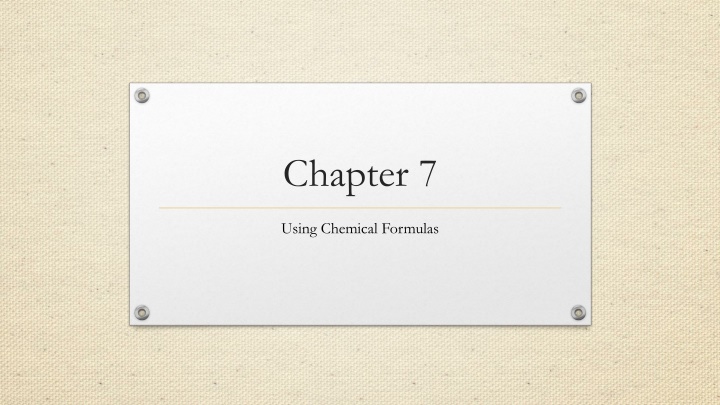
Chemical Formulas and Composition in Chemistry
Explore the concept of chemical formulas, formula mass, moles, and percent composition in chemistry. Learn how to determine the number of moles, molar mass, and percent composition of compounds. Understand the difference between empirical and molecular formulas. Practice with examples to enhance your understanding of chemical composition and formulas.
Download Presentation

Please find below an Image/Link to download the presentation.
The content on the website is provided AS IS for your information and personal use only. It may not be sold, licensed, or shared on other websites without obtaining consent from the author. If you encounter any issues during the download, it is possible that the publisher has removed the file from their server.
You are allowed to download the files provided on this website for personal or commercial use, subject to the condition that they are used lawfully. All files are the property of their respective owners.
The content on the website is provided AS IS for your information and personal use only. It may not be sold, licensed, or shared on other websites without obtaining consent from the author.
E N D
Presentation Transcript
Chapter 7 Using Chemical Formulas
Formula Mass Formula Mass the sum of the average atomic masses of all atoms represented in the formula. Numerically equal to molar mass (different units). Difference is molar mass is the total mass of 1 mol of the substance (g/mol), and formula mass is the mass of only 1 unit of that formula (amu).
Formulas Subscript numbers tell how many moles of each atom are in 1 mol of the compound or molecule. Example: Al2S3 shows there are 2 mol of Aluminum and 3 mol of Sulfur in every 1 mol of Al2S3
Practice Determine the number of moles of each atom present in the following formulas: Mg(OH)2 H2SO4 Ca(NO3)2 Determine the molar mass for each compound
REVIEW Determine the number of moles in 2.3 g of NH3 Determine the number of grams in 5 moles of Ca(NO3)2
Review: Percent composition Percent composition: mass of element in sample of compound x 100 = % element in compound mass of sample of compound mass of element in 1 mole of compound x 100 = % element in compound molar mass of compound
Percent composition Examples Determine the percent composition of KClO3 Determine the percent composition of Copper in Copper (I) Sulfide
Percent composition of Hydrates Na2CO3 10H2O - name? 10 water molecules are present for every 1 formula unit of Na2CO3 Find the mass percentage of water in sodium carbonate decahydrate:
Determining Chemical Formulas Empirical formula the formula showing the smallest whole-number mole ratio of different atoms in a compound. Molecular formula represents the actual number of atoms present in a molecule.
Whats the difference? Boiling Point (oC) -21 117 140 Empirical Formula CH2O CH2O CH2O Molecular formula CH2O C2H4O2 C3H6O3 Name of Molecule Formaldehyde Acetic Acid Glyceraldehyde
Calculation of Empirical Formulas From percent composition 3 steps Example: Compound containing 78.1% B and 21.9% H. Convert all percentages to masses out of 100 g. Convert masses to moles using molar mass of element. Divide each number of moles by smallest mole value to get ratios for empirical formula. If not whole numbers after dividing, multiply all values by whole numbers until all are made whole numbers.
Practice Quantitative analysis shows a compound with 32.38% Na, 22.65% S, and 44.99% O. Find the empirical formula of the compound. Analysis of a 10.150 g sample of a compound containing only P and O indicates a P content of 4.433 g. What is the empirical formula of the compound?
Empirical Formula of Hydrates A 5.018 gram sample of a certain hydrate of magnesium sulfate, MgSO4 xH2O, is heated until all the water is driven off. The resulting anhydrous compound weighs 2.449 grams. What is the formula of the hydrate?
Calculation of Molecular Formulas Empirical formula = smallest ratio of whole numbers, therefore the molecular formula must be thus: x(empirical formula) = molecular formula Masses are in the same form of equation x( empirical formula mass) = molecular formula mass ????????? ??????? ???? ????????? ??????? ????= ? x = the number by which to multiply ratios in empirical formula to get molecular formula
Practice Determine the molecular formula of a compound with an empirical formula of CH and a molecular mass of 78.110 amu. A sample with a formula mass of 34.00 amu consists of 0.44 g of H and 6.92 g O. Find the molecular formula.
